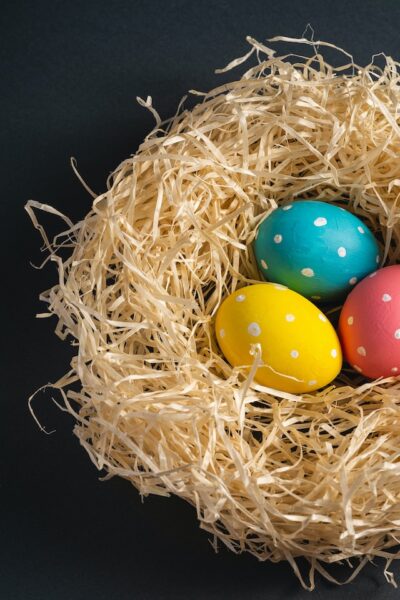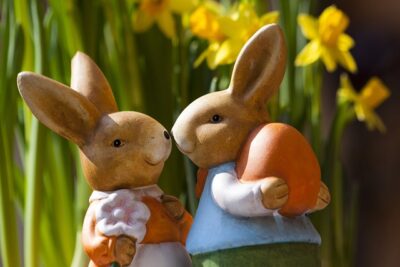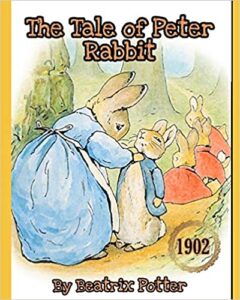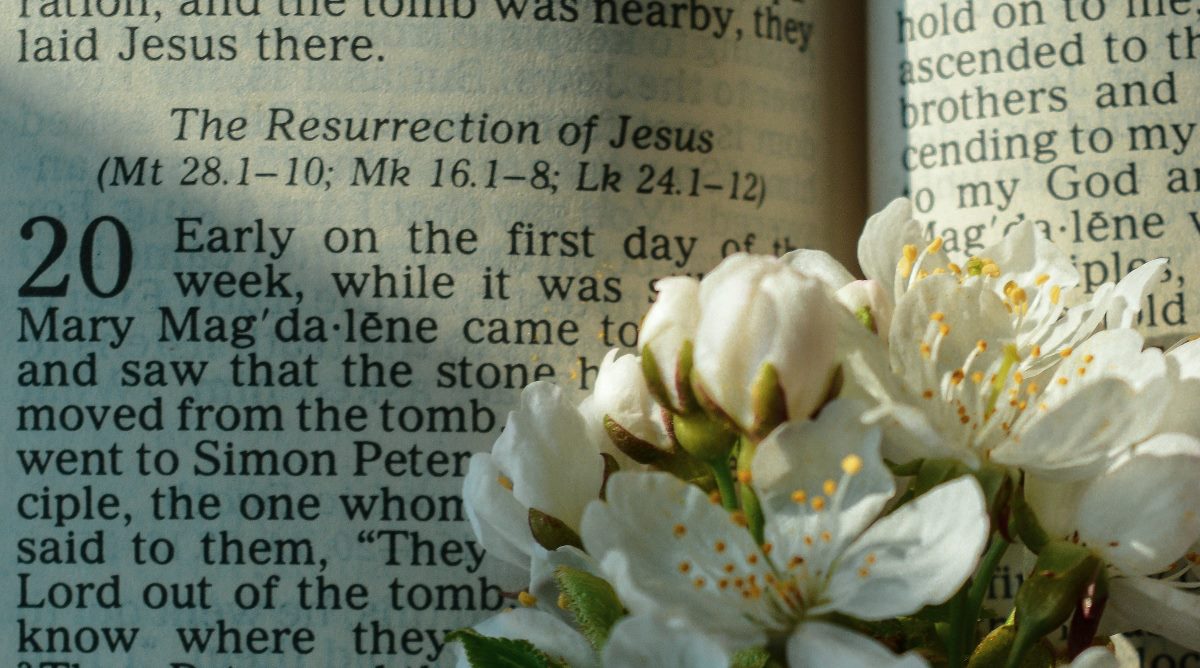When preparing to study the history of Easter, I happily remembered that I already owned a book about Easter, entitled Stories Behind the Traditions and Songs of Easter by Ace Collins. It turned out to be a great source for understanding the beginning of Easter customs. Mr. Collins eloquently explains the origins of seven different Easter customs and the stories of 21 different hymns associated with Easter. I will merely focus on summarizing the information he supplied about two Easter customs dominant today, Easter eggs and the Easter bunny, and a well-known Easter hymn called “Christ the Lord Is Risen Today.” If you enjoy reading about the stories behind hymns, you will love Ace Collins’ book. The jacket cover on the book states that Ace Collins is “the award-winning author of over sixty books,” and that he “has appeared on scores of television shows, including CBS This Morning, NBC Nightly News, CNN, Good Morning America, MSNBC, and Entertainment Tonight.”
the Traditions and Songs of Easter by Ace Collins. It turned out to be a great source for understanding the beginning of Easter customs. Mr. Collins eloquently explains the origins of seven different Easter customs and the stories of 21 different hymns associated with Easter. I will merely focus on summarizing the information he supplied about two Easter customs dominant today, Easter eggs and the Easter bunny, and a well-known Easter hymn called “Christ the Lord Is Risen Today.” If you enjoy reading about the stories behind hymns, you will love Ace Collins’ book. The jacket cover on the book states that Ace Collins is “the award-winning author of over sixty books,” and that he “has appeared on scores of television shows, including CBS This Morning, NBC Nightly News, CNN, Good Morning America, MSNBC, and Entertainment Tonight.”
The celebration of Easter appears to have been well established by the year 200. A man named Irenaeus wrote a letter to Pope Victor I, in which he said he had observed Christians from various areas celebrating Christ’s resurrection in a wide array of ways. In the early celebrations of Easter, the church established three main purposes for it. First of all, the church customarily baptized new converts on the anniversary of Jesus’ resurrection. Prior to Easter, the converts were to study the meaning of being a Christian in detailed classes taught by church leaders. Secondly, Christians were to look inside themselves and consider their own faults, in order to forsake sin and be more like Jesus. Lastly, they were to try to find the “lost sheep” and bring them back into “the fold.” In other words, those who had left their congregations were to be invited back into fellowship. The Council of Nicea of 325 is well known for having set official dates for Christmas and Easter.
 EASTER EGGS
EASTER EGGS
The idea of colored eggs in the spring goes clear back to the ancient Egyptians. Many ancient civilizations thought the world originated as an egg. When broken, the yolk became the sun, and the rest became the earth. [And I thought Darwin’s ideas were implausible.] The egg was so honored that it was placed in tombs of Egyptian noblemen and buried with Greeks who had died. Its importance was tied to the fact that the lives of many creatures originated from eggs. New life sprang up after eggs were laid in springtime, giving the world new hope.
When pagans were converted to Christianity, they still thought of the egg as symbolic of new life. When they heard about Christ coming back to life after dying on the cross and the spiritual rebirth it brought them, they naturally associated the egg with their new hope in Christ.
Long before eggs became symbols of Easter, people were participating in hunting for eggs. They went out looking for eggs from various kinds of birds as a source of food. Often they took home eggs that were brightly colored naturally as gifts for their children. That developed into a day set as a special day for children to hunt for eggs. Whichever child found the egg that was thought to be the most beautiful would win a prize. People in parts of Europe that lacked any eggs that were brightly colored naturally began dying eggs and hiding them the night prior to the hunt.
Orthodox Christians began draining the contents of some of the eggs by piercing them with a needle. Then they painted them bright red. When these eggs were found, it was explained that they represented Christ’s blood that was shed for our salvation. In parts of Europe this developed into putting images of New Testament figures on the eggs. In Germany during the Middle Ages, giving green eggs on Good Friday became a custom. They were used to decorate “Easter trees.” For several hundred years, children in Scandinavian countries and the British Isles went house to house to ask for brightly-hued eggs.
In Eastern Europe the art of decorating the eggs was frequently handed over to artists to make colorful designs. The competition resulted in elaborate decorations, using even gold, silver, and jewels.
In the Middle Ages eggs were on the list of restrictions for Lent. Once Lent was over and the children were allowed to hunt for eggs, they were very hungry for them.
Gathering eggs in a hat or sack led to lots of cracked eggs. This inspired using baskets instead. Artisans began making baskets that looked like birds’ nests, which were passed down from one generation to another.
Soon after Martin Luther broke off from the Catholic church, some of the splinter groups shunned anything related to pagan roots. But in the mid-19th century, Protestant churches in England and America began celebrating Easter once again. Easter eggs returned with Easter. During the Civil War, President Lincoln began an egg-rolling contest at the White House the Monday after Easter, which has continued every Easter to this day.
The most famous Easter eggs in the world are the ones created by an artist named Faberge’. In the latter 1800s he designed an egg covered with gold and jewels every year, as a gift for the family of the Russian czar. Inside were surprises. Today they are priceless.
Though the egg was once a pagan symbol, it became a symbol of Christian faith. It reminds us of the new life we have obtained through Christ’s death on the cross.
THE EASTER BUNNY
Unlike the Easter egg, there is no connection to be found between the Easter bunny and Christianity. However, the Easter bunny helps many children look forward to the coming of Easter.
many children look forward to the coming of Easter.
Rabbits have been thought to have mysterious powers for thousands of years. Many statues of fertility gods and goddesses were topped with heads that depicted rabbits. Of course the rabbit’s ability to multiply rapidly makes the association easy to understand.
A pagan goddess named Oestre played a big role in spring festivities. Many tribes of Europe believed she forced winter out and awakened spring. There was a legend that spoke of Oestre turning her attention to a bird. The bird saw great beauty in the features of Oestre that resembled a rabbit. The bird requested that the goddess change him into a rabbit. Oestre granted his wish the following spring. The bird-turned-rabbit could not remember anything about its previous life except the ability to lay eggs. Oestre gathered the creature’s eggs and gave them to the best children to be found in the world. When people were converted from paganism to Christianity, this rabbit was almost completely forgotten. A bunny appeared in Easter tradition only in a few aloof villages in Germany.
[The author, Ace Collins, states that the name “Oestre” MAY have been the origin of the name “Easter.” I found an article on the Answers in Genesis website, entitled “Is the Name ‘Easter’ of Pagan Origin?” Under the section called “Could There Be Another Origin of the Name ‘Easter’?” there was a very convincing argument that the name “Easter” really came from a German word used to designate the Christian celebration of Jesus’ resurrection that took place at Passover time.]
Easter egg hunts were normally held in open fields or meadows in the Middle Ages. Children often frightened rabbits hiding in the grass. Since the bunnies hopped away from the areas where the eggs were found, the children automatically connected the eggs with the rabbits. Eventually this ended up with stories of colorful eggs being laid by a rabbit.
The Easter bunny first began to appear in story books in Germany as early as the 1500s. German candy makers recognized the money-making potential of edible bunnies in the early 1800s.
 The myth of a large, white rabbit was brought to America by Dutch and German immigrants. In spring the rabbit supposedly brought beautiful eggs to children who had behaved well all year, much like Santa Claus. In the middle to late 1800s, when Americans began to celebrate Easter, this rabbit evolved into the Easter bunny. The rabbit became the subject of stories written, and department stores drew customers by having employees wear bunny suits. The candy still played an important role.
The myth of a large, white rabbit was brought to America by Dutch and German immigrants. In spring the rabbit supposedly brought beautiful eggs to children who had behaved well all year, much like Santa Claus. In the middle to late 1800s, when Americans began to celebrate Easter, this rabbit evolved into the Easter bunny. The rabbit became the subject of stories written, and department stores drew customers by having employees wear bunny suits. The candy still played an important role.
The Easter bunny no doubt helped inspire [British author] Beatrix Potter to write The Tale of Peter Rabbit [in 1893]. The famous singing cowboy named Gene Autry boosted the Easter bunny’s popularity greatly when he recorded “Peter Cottontail” in 1950.
Ace Collins tells us that a poll taken not long before he completed this book [published 2007] indicated that nearly 90% of Americans used the Easter bunny as part of their Easter festivities. The author notes that although the Easter bunny has no ties to Christianity, it has helped to keep non-Christians interested in observing Easter and has provided a link to discussing the real meaning of Easter.
THE STORY OF A POPULAR EASTER HYMN
Mr. Collins explains something about the music in Protestant churches of which I was not aware. Just a few hundred years ago the worship music in Protestant churches was dull and lifeless. Their songs came only from the Psalms, and only a few tunes had been written to accommodate them. Consequently, a church might sing three Psalms during the course of the service, and they could have been sung to the same melody.
A young English preacher and songwriter named Isaac Watts saw the need for change. Charles Wesley and others joined the revolution. In 1738 Charles Wesley composed the lyrics for the first of his over 3,000 hymns. Both his hymns and his sermons moved his listeners. Collins’ book provides much more interesting information about the life of Charles Wesley that I won’t go into here. Wesley studied theology and music simultaneously and was inspired by some old music books of the Catholic church. He was moved by a piece he discovered called “Jesus Christ Is Risen Today.” He took the hymn and transformed the wording for his evangelistic message, then renamed it “Christ the Lord Is Risen Today.” He saved the debut of the hymn for a very special occasion—the dedication service in 1739 of a foundry that had been converted into a house of worship. Later in the year that song was among others published in a hymnal called The Foundry Collection. Although it’s hard to imagine the hymn without them, the “alleluias” at the end of each line were actually tacked on at a later time by an unidentified hymnal editor.
Not all versions of this hymn use the same melody, but if you click on the Youtube picture below you will hear one version of this jubilant Easter hymn, as sung by the Amen Choir of the First Baptist Church.
Videos suggested at the end of this video are not necessarily endorsed by this website


Leave A Comment